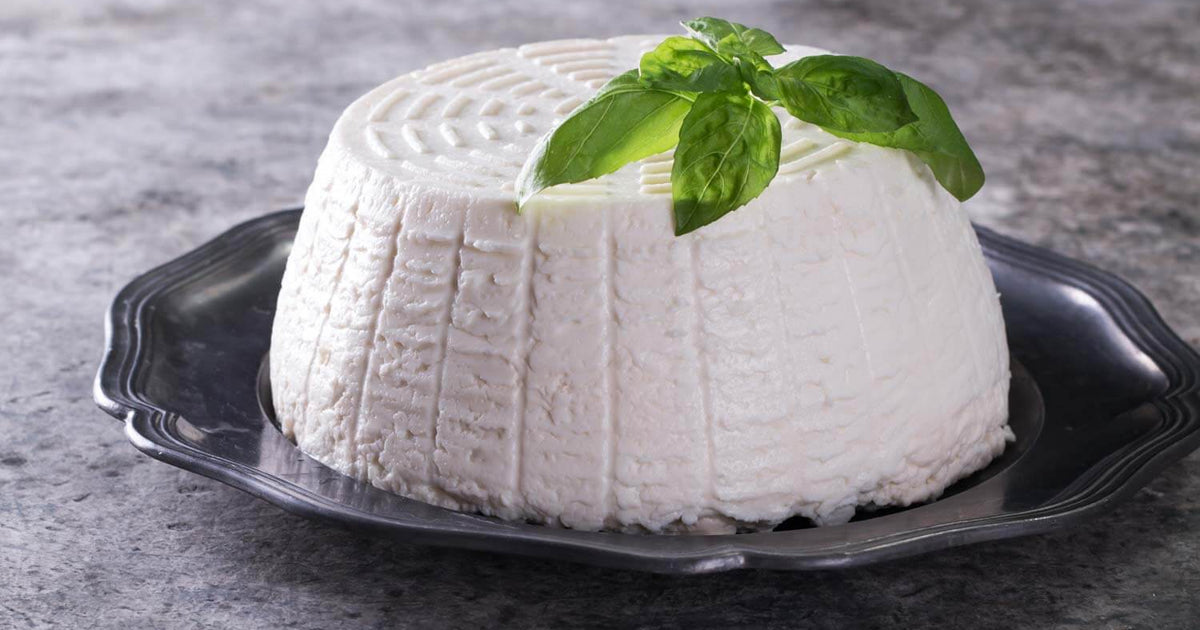
Ricotta Cheese Making Recipe
-
Yield
1 Pound
-
Aging Time
None
-
Skill Level
Beginner
-
Author
Jim Wallace

Ingredients
Total price for selected items: Total price:
Instructions
Whey Ricotta
-

Heat Whey & Add Salt
When making whey Ricotta, use leftover whey from a batch of cultured cheese. The fresher the whey the better.
Heat the whey, without agitating. Once it reaches 160°F, if desired, you can add 5-12% of fresh milk can be added to improve the richness and yield.
Continue heating to 170°F then add 1/2 tsp of salt for every gallon of whey, mix in quickly.
Continue heating without agitation to 185°F and hold at this temp until the ricotta rises.
Note: Some people heat to jsut below boiling (200F), this is not necessary, but it will not be a problem if the whey heats well into the 190's.
-

Add Citric Adic
This step is optional
Mix 1/2 tsp. of citric acid per gallon of liquid. The citric acid should be dissolved in 1/2 cup water. Add quickly the pot and stir briskly for 5-10 seconds.
Watch the curd forming small flakes and gradually larger curd masses. Add a bit more more citric acid solution if necessary.
Note: If too much acid is added, the curds will sink to the bottom and the cheese will not be sweet. The correct amount of acid will produce a clear separation of white curds and bright green whey.
-



Gently Move Curd
As the curds rise, use a perforated ladle to gently move them from the sides to the center of the pot. These clumps of curd will begin to consolidate floating on top of the liquid.
Let the curds rest for 10-15 minutes. This is important because it is the point where the final Ricotta quality is assured.
-


Drain Ricotta
Ladle the curds gently into draining forms (No cheese cloth should be needed if you were patient in the previous step). Let the curds drain for 15 min up to several hours.
For a fresh light ricotta, drain it for a short while (until the free whey drainage slows) and chill to below 50F. For a rich, dense and buttery texture allow it to drain for an extended period of time (several hours). before chilling overnight
Move to a refrigerator or cold room. Consume within 10 days.
Whole Milk Ricotta
For this recipe use whole milk. the fresher the better.
-
Prepare Citric Acid
Add 2 tsp of citric acid per gallon of milk used and dissolve this in 1 cup cool water.
Add 1/2 of the Citric Acid solution to one gallon of milk, save the rest of the citric acid.
Stir the milk briskly for 5-10 seconds.
-
Heat Milk
Add 1 tsp of salt to the milk then heat the milk slowly on low to med heat, stirring well to prevent scorching
-
Extra Citric Acid, if Needed
At 165-170F watch for small flakes forming in the milk and the separation into small flaky curds.
If after a few minutes you do not see the flakes forming, add more of the Citric acid until they form. Do this in 1 Tbsp increments, to avoid over acid milk.
At this point, when you see the curds, A slower stirring is essential to avoid breaking up the small bits of curd that have formed. Excess stirring will cause smaller and very granular curds to form. I tend to just roll the milk slowly with a bottom to top stirring motion.
-
Gently Move Curd
Continue heating to 190-195F then turn the heat off. The thermal mass of the whey will hold at this temp for quite some time. The higher temp is used here because of the additional proteins found in whole milk vs whey.
As the curds rise, use a perforated ladle to gently move them from the sides to the center of the pot. These clumps of curd will begin to consolidate floating on top of the liquid.
Let the curds rest for 10-15 minutes. This is important because it is the point where the final Ricotta quality is assured.
-
Drain Ricotta
Ladle the curds gently into draining forms. No cheese cloth should be needed if you were patient in the previous step. Let the curds drain for 15 min up to several hours.
For a fresh light ricotta, drain it for a short while, until the free whey drainage slows, and chill to below 50F. For a rich, dense and buttery texture allow it to drain for an extended period of time (several hours). before chilling overnight
Move to a refrigerator or cold room. Consume within 10 days
Ricotta Salata
This recipe should begin after the draining step in either of the above recipes.
-
Drain Ricotta
Let drain for an extended period of 24-36 hours
After the first 6-8 hours place a weight on top of the cheese, 2-4 lbs should be enough.
-
Salt Ricotta
After draining, de-mold the Ricotta onto a plate or bowl that will catch extra whey. Every other day for at least the first week sprinkle about 1/2 tsp of salt over the cheese, rubbing over the outside of the cheese, then cover the top with plastic returning it to the refrigerator.
Pour off any whey that weeps out of the salted cheese.
-
Age
As the cheese starts to firm up and lose less whey you can salt less often until it is pretty firm, at least a week and a half if not two or three.
The final cheese can be anywhere from a firm table cheese after 4-6 weeks or a very dry grating cheese after several months.
Keep the mold under control by wiping with a light brine as it appears
Cheese Making Supplies
Related Products
You May Also Like


































